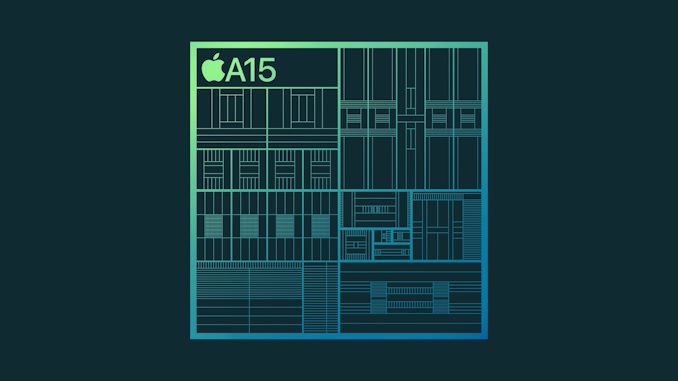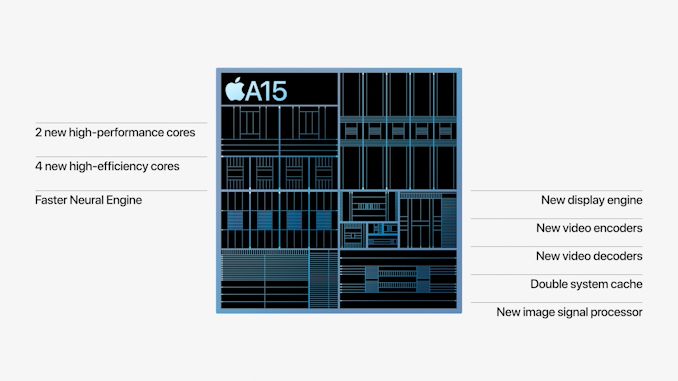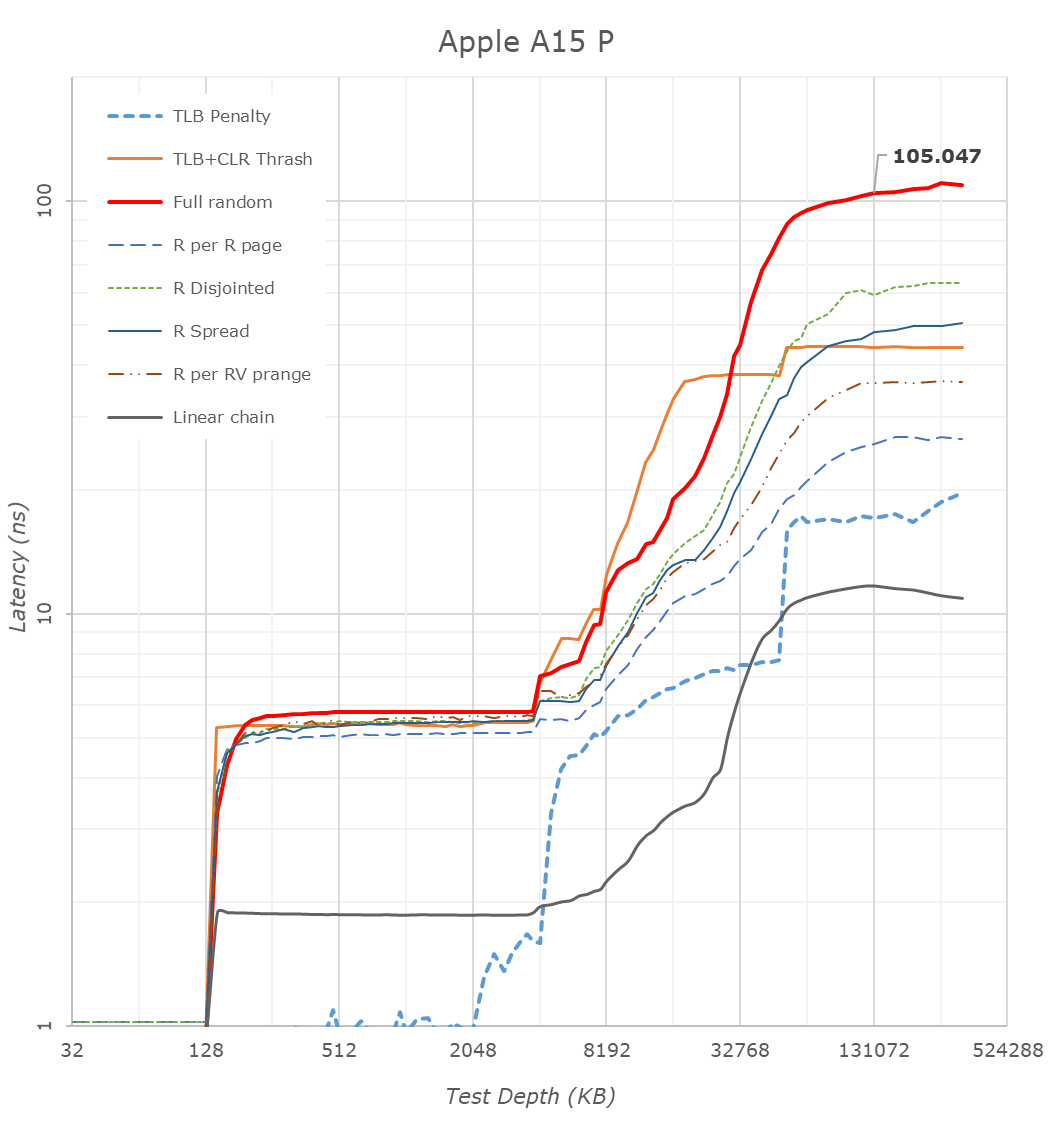The Apple A15 SoC Performance Review: Faster & More Efficient
by Andrei Frumusanu on October 4, 2021 9:30 AM EST- Posted in
- Mobile
- Apple
- Smartphones
- Apple A15

A few weeks ago, we’ve seen Apple announce their newest iPhone 13 series devices, a set of phones being powered by the newest Apple A15 SoC. Today, in advance of the full device review which we’ll cover in the near future, we’re taking a closer look at the new generation chipset, looking at what exactly Apple has changed in the new silicon, and whether it lives up to the hype.
This year’s announcement of the A15 was a bit odder on Apple’s PR side of things, notably because the company generally avoided making any generational comparisons between the new design to Apple’s own A14. Particularly notable was the fact that Apple preferred to describe the SoC in context of the competition; while that’s not unusual on the Mac side of things, it was something that this year stood out more than usual for the iPhone announcement.
The few concrete factoids about the A15 were that Apple is using new designs for their CPUs, a faster Neural engine, a new 4- or 5-core GPU depending on the iPhone variant, and a whole new display pipeline and media hardware block for video encoding and decoding, alongside new ISP improvements for camera quality advancements.
On the CPU side of things, improvements were very vague in that Apple quoted to be 50% faster than the competition, and the GPU performance metrics were also made in such a manner, describing the 4-core GPU A15 being +30% faster than the competition, and the 5-core variant being +50% faster. We’ve put the SoC through its initial paces, and in today’s article we’ll be focusing on the exact performance and efficiency metrics of the new chip.
Frequency Boosts; 3.24GHz Performance & 2.0GHz Efficiency Cores
Starting off with the CPU side of things, the new A15 is said to feature two new CPU microarchitectures, both for the performance cores as well as the efficiency cores. The first few reports about the performance of the new cores were focused around the frequencies, which we can now confirm in our measurements:
| Maximum Frequency vs Loaded Threads Per-Core Maximum MHz |
||||||
| Apple A15 | 1 | 2 | 3 | 4 | ||
| Performance 1 | 3240 | 3180 | ||||
| Performance 2 | 3180 | |||||
| Efficiency 1 | 2016 | 2016 | 2016 | 2016 | ||
| Efficiency 2 | 2016 | 2016 | 2016 | |||
| Efficiency 3 | 2016 | 2016 | ||||
| Efficiency 4 | 2016 | |||||
| Maximum Frequency vs Loaded Threads Per-Core Maximum MHz |
||||||
| Apple A14 | 1 | 2 | 3 | 4 | ||
| Performance 1 | 2998 | 2890 | ||||
| Performance 2 | 2890 | |||||
| Efficiency 1 | 1823 | 1823 | 1823 | 1823 | ||
| Efficiency 2 | 1823 | 1823 | 1823 | |||
| Efficiency 3 | 1823 | 1823 | ||||
| Efficiency 4 | 1823 | |||||
Compared to the A14, the new A15 increases the peak single-core frequency of the two-performance core cluster by 8%, now reaching up to 3240MHz compared to the 2998MHz of the previous generation. When both performance cores are active, their operating frequency actually goes up by 10%, both now running at an aggressive 3180MHz compared to the previous generation’s 2890MHz.
In general, Apple’s frequency increases here are quite aggressive given the fact that it’s quite hard to push this performance aspect of a design, especially when we’re not expecting major performance gains on the part of the new process node. The A15 should be made on an N5P node variant from TSMC, although neither company really discloses the exact details of the design. TSMC claims a +5% frequency increase over N5, so for Apple to have gone further beyond this would have indicated an increase in power consumption, something to keep in mind of when we dive deeper into the power characteristics of the CPUs.
The E-cores of the A15 are now able to clock up to 2016MHz, a 10.5% increase over the A14’s cores. The frequency here is independent of the performance cores, as in the number of threads in the cluster doesn’t affect the other cluster, or vice-versa. Apple has done some more interesting changes to the little cores this generation, which we’ll come to in a bit.
Giant Caches: Performance CPU L2 to 12MB, SLC to Massive 32MB
One more straightforward technical detail Apple revealed during its launch was that the A15 now features double the system cache compared to the A14. Two years ago we had detailed the A13’s new SLC which had grown from 8MB in the A12 to 16MB, a size that was also kept constant in the A14 generation. Apple claiming they’ve doubled this would consequently mean it’s 32MB now in the A15.
Looking at our latency tests on the new A15, we can indeed now confirm that the SLC has now doubled up to 32MB, further pushing the memory depth to reach DRAM. Apple’s SLC is likely to be a key factor in the power efficiency of the chip, being able to keep memory accesses on the same silicon rather than going out to slower, and more power inefficient DRAM. We’ve seen these types of last-level caches being employed by more SoC vendors, but at 32MB, the new A15 dwarfs the competition’s implementations, such as the 3MB SLC on the Snapdragon 888 or the estimated 6-8MB SLC on the Exynos 2100.
What Apple didn’t divulge, is also changes to the L2 cache of the performance cores, which has now grown by 50% from 8MB to 12MB. This was actually the same L2 size as on the Apple M1, only this time around it’s serving only two performance cores rather than four. The access latency appears to have risen from 16 cycles on the A14 to 18 cycles on the A15.
A 12MB L2 is again humongous, over double compared to the combined L3+L2 (4+1+3x0.5 = 6.5MB) of other designs such as the Snapdragon 888. It very much appears Apple has invested a lot of SRAM into this year’s SoC generation.
The efficiency cores this year don’t seem to have changed their cache sizes, remaining at 64KB L1D’s and 4MB shared L2’s, however we see Apple has increased the L2 TLB to 2048 entries, now covering up to 32MB, likely to facilitate better SLC access latencies. Interestingly, Apple this year now allows the efficiency cores to have faster DRAM access, with latencies now at around 130ns versus the +215ns on the A14, again something to keep in mind of in the next performance section of the article.
CPU Microarchitecture Changes: A Slow(er) Year?
This year’s CPU microarchitectures were a bit of a wildcard. Earlier this year, Arm had announced the new Armv9 ISA, predominantly defined by the new SVE2 SIMD instruction set, as well as the company’s new Cortex series CPU IP which employs the new architecture. Back in 2013, Apple was notorious for being the first on the market with an Armv8 CPU, the first 64-bit capable mobile design. Given that context, I had generally expected this year’s generation to introduce v9 as well, but however that doesn’t seem to be the case for the A15.
Microarchitecturally, the new performance cores on the A15 doesn’t seem to differ much from last year’s designs. I haven’t invested the time yet to look at every nook and cranny of the design, but at least the back-end of the processor is identical in throughput and latencies compared to the A14 performance cores.
The efficiency cores have had more changes, alongside some of the memory subsystem TLB changes, the new E-core now gains an extra integer ALU, bringing the total up to 4, up from the previous 3. The core for some time no longer could be called “little” by any means, and it seems to have grown even more this year, again, something we’ll showcase in the performance section.
The possible reason for Apple’s more moderate micro-architectural changes this year might be a storm of a few factors – Apple had notably lost their lead architect on the big performance cores, as well as parts of the design teams, to Nuvia back in 2019 (later acquired by Qualcomm earlier this year). The shift towards Armv9 might also imply some more work done on the design, and the pandemic situation might also have contributed to some non-ideal execution. We’ll have to examine next year’s A16 to really determine if Apple’s design cadence has slowed down, or whether this was merely just a slippage, or simply a lull before a much larger change in the next microarchitecture.
Of course, the tone here paints rather conservative improvement of the A15’s CPUs, which when looking at performance and efficiency, are anything but that.












204 Comments
View All Comments
Calin - Tuesday, October 5, 2021 - link
There are plenty of Android phones with batteries around 5,000 mAh. However, I only remember one at 6,000 mAh and none higher than that.All in all, anything more than about 18-20 hours of actual battery life is excessive (considering the size and weight penalty versus actual time you could use it between recharges).
gund8912 - Monday, October 11, 2021 - link
I care about battery line not size of the battery.markiz - Monday, October 11, 2021 - link
They really don't. They have been at the bottom of any list for many years now, compared to other high end phones, and even more so compared to some cheaper phones.13 series does seem like a significant improvement though.
michael2k - Friday, October 15, 2021 - link
Very significant:https://www.anandtech.com/show/17004/apples-iphone...
akdj - Wednesday, February 16, 2022 - link
???I know I’m late to the party but whaaaa…?
As an owner of both, and since 2007 - it’s been a long time since I’ve seen/had/read about Android beating iPhone in any sort of battery or power longevity test… in real world usage.
And I believe there’s a limit to the size of battery allowed in a cell phone if you need or want to fly with it.
If I recall correctly it was, maybe still is 4,000mAh but I could be wrong
That said, the 11, 12, and now 13 Pro Max’s I’ve owned have eaten the S20, S21 Ultra and the Pix6 for lunch when it comes to measuring battery life.
I only mention these because I owned them simultaneously with each other and used them similarly so I speak from experience
That said, I don’t think it’s hard to believe a low powered cheap/burner Android phone has decent battery life. It probably forgoes a lot of radio power, cell bands and Wi-Fi options/radios. No NFC, LTE only with just local frequencies, maybe even 3g. A/B/G, maybe N Wi-Fi, small display and no always on. No storage for apps that eat your bandwidth and in turn your battery. Dim displays, tired SOCs, little RAM, little storage, and with the lack of power storage and memory comes the lack of desire to play games, buy decent apps, or even watch movies.
So sure, you might get a couple extra standby hours on a cheap Android but not a flagship option. I think my S21U had 12GB RAM! That’s insane and needs continued low voltage to maintain the info on your immediate random access memory!
The only options I’ve seen that truly do compete with the iPhone energy wise are either not available in America (only our problem), in some case Europe or are just not readily available in many western carriers.
And the flagships are usually neck and neck until the recent iPhone updates (since it seems the X/XS or 11 series) where they have just taken over with few exceptions that are hard if not impossible to find - even worse to get support.
Apple’s chip design is a massive achievement, and I believe one we’ve just begun to see the fruits of that labor. EG; M1/M1 Pr/M1 Max and soon to release M2’s architecture and the scaling used from the iPhone silicon to the Mac Pros.
Just the beginning… and if you want to game, all ya need now is an Xbox, leave the rest of the Wind-blows in the rear view (I’m playing Microsoft Flight Simulator 2021 on the series X and I have a desktop rig with a 3080. I notice almost no difference between them - Other than options for third party upgrades, liveries and high density airports - I believe will be here sooner than later on Xbox. As it, too, is running Windows at its core.
Why chase three and four thousand dollar gaming rigs when they offer a $500 box that every Tom Dick and Henry the developers will be targeting the next several years?
Makes little to no sense. Not even in productivity or code compilation.
Sure, Alder Lake unlocked and a 3090 ($2500-$3000 if you can find one, GPU only) can best the MacBook Pro M1 Max, but not by much (games aside, remember the Xbox) in the benchmarks or actual software that was tested for making and printing money - ala Photoshop, Premier and After Effects, Audition and FCP/Logic - massive spreadsheets or huge RAW file batch processing in Lightroom, not only does the M1 crush in the laptop realm but it’s a monster on the iPhone 12/13 and the 2021 iPad with M1! And you don’t need to worry, your battery will last all day
Ppietra - Monday, October 4, 2021 - link
You can see that S21U at 8.3W only achieves 120 fps, almost the same as the A15 at 3W.melgross - Monday, October 4, 2021 - link
You seem to be just making things up. Apple’s new phones are getting excellent battery life according to every review, with the 13 Pro Max being given the top rating for battery life.18,000mAh battery? What phone has that?
emn13 - Monday, October 4, 2021 - link
The largest battery I can find is the one: "doogee s88 pro" which is "just" 10000mAh.However, even if deil is exaggerating, there is a kernel of truth to the battery life complaints, and that's due to idle power draw, which apparently is not as great.
gsmarena (link unfortunately removed to satisfy the absurd anandtech spam detector) has a battery life estimator, based on a sliding scales of how much legacy calling/web browsing/video watching you do, but critically it includes the standby power draw, and apple devices are nowhere near the top. The best rated is still the 11 Pro Max, which beats the 13 and 13 pro by a considerable margin.
But even vs. more normally battery-endowed androids (which often still tend to have 4000mAh+ batteries) although the iphone fare OK, they're nothing special. The
Sony Xperia 10 III scores particularly well (probably because it's much slower), at 137h vs. the iphone 13's 89h.
But you can fiddle the sliders to your hearts content. The higher your active usage, the better apple does, but even the most extreme users will likely see longer battery life on the more efficiently tuned androids.
Course, there are also androids that do a lot worse, mind you; it's just that apples phenomenal efficiency under load doesn't translate trivially to battery life because the batteries are still quite small, and perhaps because standby draw isn't anything particularly great.
The Garden Variety - Monday, October 4, 2021 - link
There actually was an 18,000mAh phone. It was made by Energizer (yeah, that one) and called the Power Max P18K Pop. Announced in 2019, offered for sale only in Europe, dunno if it's still available. Some quick Googling would say no. Oh, and it was the size of a particularly beefy paperback book.FunBunny2 - Monday, October 4, 2021 - link
Oh, and it was the size of a particularly beefy paperback book.dredge up a lower brain stem memory, OK! there was a flashback scene in a late "X Files" where Mulder pulls one of the vewy, vewy early mobiiiile phones from his trench coat. you remember, the ones the size of a baseball bat?